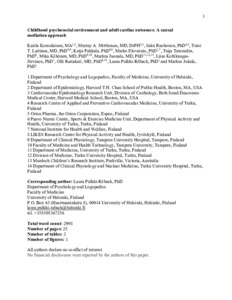Childhood Psychosocial Environment and Adult Cardiac Health: A Causal Mediation Approach
Tammelin T; Keltikangas-Järvinen L; Kähönen M; Juonala M; Laitinen TT; Raitakari O; Jokela M; Pahkala K; Ruohonen S; Pulkki-Råback L; Elovainio M; Mittleman MA; Komulainen K
https://urn.fi/URN:NBN:fi-fe2021042827065
Tiivistelmä
INTRODUCTION:
This study used causal mediation analysis to assess the life-course associations of a favorable childhood psychosocial environment with left ventricular mass and diastolic function in adulthood and the extent to which adult health behaviors mediate these associations.
METHODS:
The sample included 880 participants (56% women) from the Young Finns Study with data on the childhood environment from 1980, adult health behaviors (smoking, physical activity, diet, and BMI) from 2001 and an echocardiographic assessment of the left ventricular mass (g/m2.7) and
diastolic function (E/e' ratio; higher values indicating a lower diastolic function) from 2011. The associations of the childhood environment with the left ventricular mass and E/e' ratio and mediation pathways through health behaviors were assessed using marginal structural models that were controlled for age, sex, and time-dependent confounding by adult socioeconomic position (measured as educational attainment) via inverse probability weighting. The data were analyzed in 2018-2019.
RESULTS:
The mean age in 2011 was 41 (range 34-49) years. Those above versus below the median childhood score had a 1.28 g/m2.7 lower left ventricular mass (95% CI= -2.63, 0.07) and a 0.18 lower E/e' ratio (95% CI= -0.39, 0.03). There was no evidence for indirect effects from childhood environments to left ventricular outcomes through adult
health behaviors after controlling for time-dependent confounding by the adult socioeconomic position (indirect effect β= -0.30, 95% CI= -1.22,
0.63 for left ventricular mass; β= -0.04, 95% CI= -0.18, 0.11 for E/e' ratio). The results after multiple imputation were similar.
CONCLUSIONS:
A favorable childhood environment is associated with more optimal cardiac structure and function in adulthood. After accounting for socioeconomic positions, adult health behaviors explain little of the associations.
Kokoelmat
- Rinnakkaistallenteet [19207]
